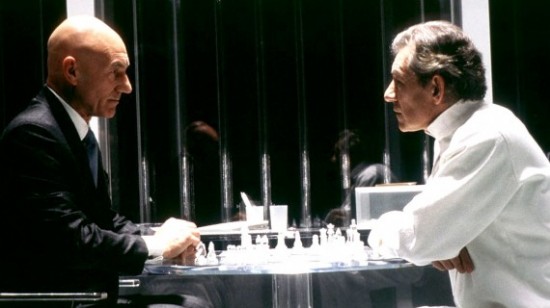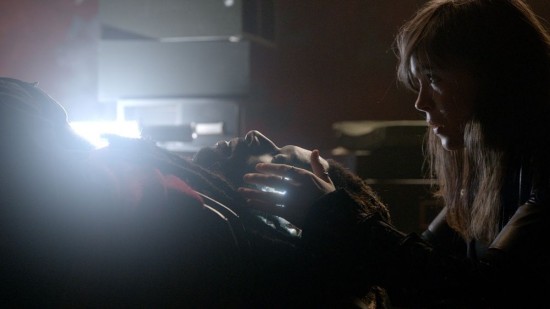Five Big Continuity Issues In 'X-Men: Days Of Future Past'
Bryan Singer's X-Men: Days of Future Past is my favorite film of the summer so far. (See Russ's review here.) Singer's return to the X-Men universe deftly combines two disparate timelines and delivers spectacular action set pieces, plus it has the emotional heft to make that action mean something. It's an achievement on par with Whedon accomplished with The Avengers, and it breathes new life back into a franchise that seemed to be on the wane.
One of the appeals of a film like this is that it can pay off at least some of the character development and plot work from the films that have come before. But when I tried to connect the dots between past X-Men films and this one, a few of the plot details really left me scratching my head. I try to break down five of these after the jump. The following contains spoilers for all X-Men-related films prior to Days of Future Past, and some very basic plot details for Days of Future Past.
1) How is Charles Xavier still alive? - Ah, the post-credits stinger. Sometimes great for sending out the audience on a high note, but often most useful for forcing people to ask their comic book-reading friends "WTF that was all about?" In one of the most effective scenes in Brett Ratner's otherwise forgettable X3, Jean Grey/Phoenix kills Professor Xavier with her telekinetic powers. Not only did this end one of the most beloved characters of the franchise, but it also showed us that Grey's transformation into the Phoenix was complete; there was no going back to her old self after this.
In the stinger after X3 (embedded above), we hear Xavier's voice coming out of another dude's body, calling out to Moira McTaggart. What exactly is going on here? Earlier in the film, Xavier commented on the ability to throw his consciousness into another person, and in the DVD commentary of X3, Ratner reveals that this is the identical twin of Xavier. This development is never explained in subsequent films, nor was the aftermath of this ever mentioned again. I guess his identical twin is also wheelchair bound? Even though we learn in First Class that Xavier was wheelchair bound due to an injury received while fighting Magneto? The next time we see Xavier is during the stinger at the end of The Wolverine.
In any case, seems like a major plot point to elide. There's no shame in killing a character and bringing him back; it happens in comic books and movies all the time. But why not make a bigger deal of his return? Why confine it to a post-credits sequence in a movie that many Days of Future past people might not even have seen?
2) How did Magneto get his powers back? - A major plot point in X3 is the development of a serum that will remove mutant powers. In fact, the failure to explore the implications of using this serum is one of the biggest missed opportunities of that film. In any case, Magneto has the serum used on him and is foiled in his plans to kill all humans. But right at the end, we see Magneto attempting to move a chess piece and it budges ever so slightly before we smash cut to credits. I actually really like the way the scene is done, including its implication that "life/mutants will always find a way."
But what the heck happened after this scene? Do we just assume Magneto's powers are back? I guess so, because in the stinger for The Wolverine AND in Days of Future Past, we not only see that Magneto's powers are back, but they're back in full force. Magneto is able to perform crazy feats with his powers and he's apparently fully recovered. So I guess the serum was never going to be a big deal anyway? Thus nullifying the entire plot driver of X3?
3) Wolverine's bone claws – At the end of The Wolverine, Wolverine's adamantium claws are severed, leaving only stumps of bone claws. We even see his bone claws come out in the stinger after the credits. (They can presumably heal along with the rest of him.) This stinger is clearly meant to show that Xavier and Magneto need Wolverine's help for something big; in Days of Future Past, we learn that Wolverine is the only one who can teleport back in time. Is that supposed to be the connection we make between this stinger and the plot of Days?
There are a couple of issues here. Firstly, since Days takes place a decade after the events of The Wolverine, Wolverine has clearly been totally ineffective at helping the mutants out of their jam in the meantime. The Sentinels already rule the earth by the time Days begins, so I guess in the stinger, Professor X and Magneto just needed Wolverine be part of the resistance for a bit while they figured out a way out of this mess?
Secondly, Wolverine has bone claws in the above scene! Whereas in Days of Future Past, he has adamantium claws. I guess he got his adamantium back in the time that takes place between The Wolverine and Days? Whatever the case, the events of The Wolverine are pretty much completely nullified, or at the very least, made irrelevant by the time Days transpires.
4) So Kitty Pryde can teleport people's consciousness back in time now? – Kitty Pryde (played by Ellen Page) had some cool moments in X3, as her ability to pass through walls saved Jimmy from Juggernaut. But in Days of Future Past, we learn that she has the ability to teleport people's consciousness back in time. Cool trick bro, but wouldn't this ability have come in handy during X3 too, to y'know, stop all the carnage that happened in that film? I guess she must've developed that ability later...
This is almost definitely a nod to Pryde's role in the original Days of Future Past storyline in the comics, in which it's Pryde's consciousness who is transported back in time, not Wolverine's.
 5) How did Xavier and Magneto team up? - This one is not so much a continuity issue as it is a missed opportunity. But by the time the stinger at the end of The Wolverine rolls around, we see that Xavier and Magneto have united to stand against an even greater threat: The Sentinels. The dynamic between these two characters has always been one of the most interesting elements of the series, right from the first big screen version of Singer's X-Men in 2000. So why leave this crucial change of heart by both characters out of the films?
5) How did Xavier and Magneto team up? - This one is not so much a continuity issue as it is a missed opportunity. But by the time the stinger at the end of The Wolverine rolls around, we see that Xavier and Magneto have united to stand against an even greater threat: The Sentinels. The dynamic between these two characters has always been one of the most interesting elements of the series, right from the first big screen version of Singer's X-Men in 2000. So why leave this crucial change of heart by both characters out of the films?
At the end of X3, Xavier is dead and Magneto has no powers. By the time The Wolverine rolls around, Xavier is alive, Magneto has his powers back, and the two of them, who've had (at best) an acrimonious relationship, are now brought together by a greater threat? So much transpires and we're expected to just accept it with absolutely no explanation whatsoever. Kind of disappointing.
***
At the end of the day, none of these issues are particularly important to the success of Days of Future Past, artistically or commercially. In fact, I personally feel like Days of Future Past works best if you just completely ignore the events of X3 entirely. (All save Jean's death, at least.) It feels like Singer and writer Simon Kinberg essentially pick and choose the continuity elements they want, and retcon everything else away.
It's a fine way to create exactly the movie that you want, at which I think they succeed with Days. But it's not so great for creating a universe that people feel like they can fully invest in.

